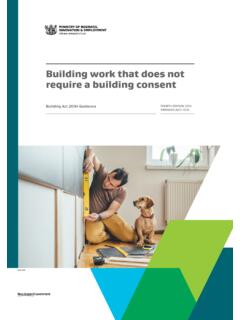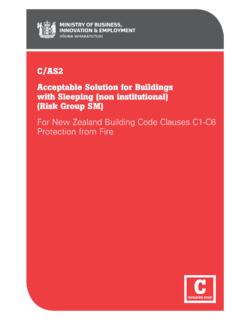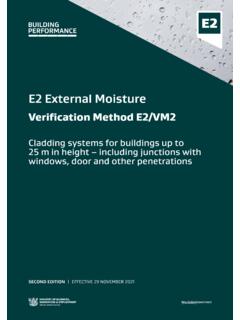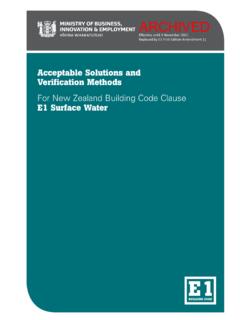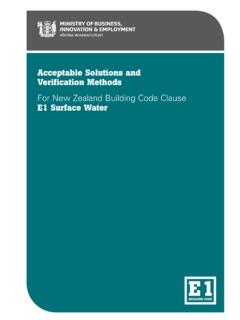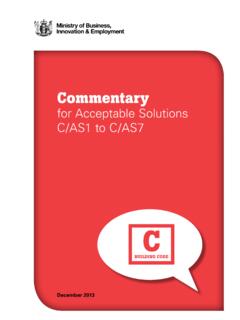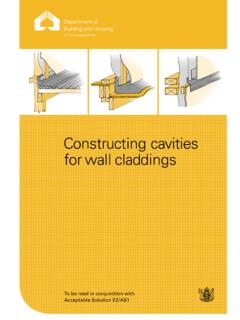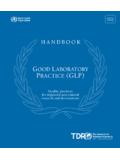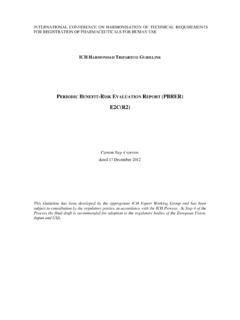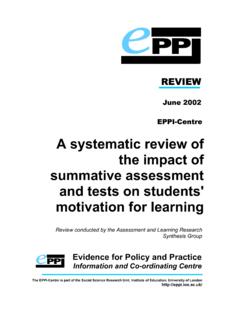Transcription of Earthquake geotechnical engineering practice
1 Earthquake geotechnical engineering practiceModule !. Ground improvement of soils prone to liquefactionNovember !"!#ISBN (print) 978-1-98-851736-0 ISBN (online) 978-1-98-851735-3iMODULE 5: GROUND IMPROVEMENT OF SOILS PRONE TO LIQUEFACTIONC ontentsAcknowledgements ..ivPreface ..vi1 Introduction ..1!.! Objective ..!!." Scope .."2 site and liquefaction considerations ..3".! site characterisation ..#"." Liquefaction considerations ..$Liquefaction evaluation ..$Effects of liquefaction on buildings ..$3 Ground improvement principles ..5#.! Methods of ground improvement ..%Replacement ..&Densification ..&Solidification ..&Reinforcement ..&Drainage ..&#." Seismic response of buildings supported on improved ground ..'Effects on structural response ..'Deformation modes ..'4 Performance requirements ..12$.! Regulatory requirements ..!"$." Ground improvement performance objectives.
2 !#5 Ground improvement design ..14%.! Design process ..!$%." Selection of ground improvement method ..!%%.# Extent of ground improvement below buildings with shallow footings ..!% Earthquake geotechnical engineering PRACTICEiiDepth of treatment ..!&Lateral extent of treatment ..!'Mitigation of lateral spreading effects on buildings ..!)%.$ Drainage blankets ..!*%.% Other considerations .."+Quality control and quality assurance .."+Environmental constraints .."+6 Replacement methods ..21&.! Outline .."!&." site conditions suitable for replacement .."!&.# Design considerations ..""7 Densification methods ..23'.! Outline .."#'. " site conditions suitable for densification .."$'. # Design considerations .."%'. $ Design verification .."''.% Dynamic compaction .."''.& Vibro-compaction ..#+'.' Stone columns ..#"'.) Compaction piles ..#$'.* Compaction grouting ..#$'.!+ Resin injection.
3 #%8 Solidification methods ..37).! Outline ..#')." Techniques for #)).# site conditions suitable for solidification ..#)).$ Design considerations ..#*).% Design verification and quality control ..$+).& Soil mixing ..$+).' Jet grouting ..$!).) Permeation grouting ..$!iiiMODULE 5: GROUND IMPROVEMENT OF SOILS PRONE TO LIQUEFACTION9 Reinforcement methods ..42*.! Outline ..$"*." Techniques for reinforcement ..$#*.# site conditions suitable for reinforcement ..$#*.$ Design considerations ..$$*.% Design verification ..$$*.& Lattice reinforcement ..$$*.' Stiff columnar reinforcement grids ..$%10 Drainage !+.! Outline ..$&!+." Permanent dewatering ..$'!+.# Vertical drains ..$)11 Ground improvement for residential construction ..49!!.! Applicability ..%+!!." Design philosophy ..%+!!.# Liquefaction mitigation strategies ..%!!!.$ Ground improvement mechanisms ..%!!!.% Selection criteria.
4 %$!!.& Specification, construction and quality control ..%$!!.' Findings from EQC ground improvement trials ..%%12 Procurement for design and construction ..5613 References ..58 Appendix. Worked A ..&' site B ..'"Example !: Shallow undercut and replacement with a dense gravel raft ..'&Example ": Shallow undercut and replacement with a reinforced cement-soil mixed raft ..)"Example #: Stone columns ..)$Example $: Dynamic compaction ..!+"Example %: Controlled modulus columns ..!+'Example &: Lattice reinforcement ..!!" Earthquake geotechnical engineering PRACTICEivAcknowledgementsNZGS/MBIE EDITORIAL PANEL FOR REVISION Campbell Keepa, ,WSP (lead author) Dr Alexei Murashev, ,WSP (lead author) Prof Misko Cubrinovski, ,University of Canterbury Dr Kevin J McManus, ,McManus Geotech Ltd Nick Traylen, ,Geotech Consulting Ltd Rick Wentz, ,Wentz Pacific Ltd Mike Stannard, , engineering New Zealand (project lead) Tony Fairclough, ,Tonkin & Taylor John Scott, ,EQC Kiran Saligame, ,Ministry of Business, Innovation & Employment Ananth Balachandra, ,NZGSNZGS/MBIE EDITORIAL PANEL AND CONTRIBUTORS FOR REVISION 0 !
5 PUBLISHED JUNE 20167" Prof R Orense, ,University of Auckland Prof Misko Cubrinovski Dr Kevin J McManus Charlie Price, ,Stantec, NZGS Chair John Scott, ,MBIE Dr Gilles Seve, ,MBIE Mike Stannard, ,MBIE Nick Traylen Rick Wentz Phil Clayton, ,Beca Infrastructure Tony Fairclough Nick Wharmby, ,March Construction Ltd Stuart Palmer, ,Tonkin & Taylor Prof Jonathon Bray, ,University of California, Berkeley Dr Geoffrey Martin, ,University of Southern California Prof Susumu Yasuda, ,Tokyo Denki University, JapanMINISTRY OF BUSINESS, INNOVATION & EMPLOYMENT Jenni TiplerNZGS MANAGEMENT Ross RobertsENGINEERING NEW ZEALAND Kaya Yamabe Eleanor Laban Tania WilliamsEQC Jo HorrocksvMODULE 5: GROUND IMPROVEMENT OF SOILS PRONE TO LIQUEFACTIONDOCUMENT STATUSISBN (print) 978-1-98-851736-0 ISBN (online) 978-1-98-851735-3 New Zealand geotechnical Society (NZGS) and Ministry of Business, Innovation & Employment (MBIE) Earthquake geotechnical engineering practice in New ZealandRev 1 Issue date November 2021 New Zealand geotechnical Society (NZGS) c/ engineering New Zealand PO Box 12 241 Wellington 6013 Ministry of Business Innovation & Employment (MBIE) Building System Performance Branch PO Box 1473 Wellington 6140 DISCLAIMERThis document is published by the Chief Executive of MBIE as guidance under section 175 of the Building Act 2004 to assist parties to comply with their obligations under the Building Act 2004.
6 It is not mandatory to follow the guidance, but if followed: it does not relieve any person of the obligation to consider any matter to which that information relates according to the circumstances of the particular case; users should consider taking appropriate professional advice prior to entering into a construction contract which incorporates all or parts of this document. While the Ministry of Business, Innovation & Employment, engineering New Zealand and the New Zealand geotechnical Society have taken care in preparing this document, it is only a guide. It is not a substitute for legal advice or legislation. All users should satisfy themselves as to the applicability of the content and should not act on the basis of any matter contained in this document without considering, and if necessary, taking appropriate professional advice. The document may be updated from time to time and the latest version is available from the Ministry s website at or the New Zealand geotechnical Society s website at NOTICEThe contents may be subject to changes, additions, and deletions.
7 Submissions by the geotechnical community to the Society are encouraged, as it is intended that the guidelines will be updated from time to time. COPYRIGHT The copyright owner authorises reproduction of this work, in whole or in part, so long as no charge is made for the supply of copies, and the integrity and attribution of the contributors and publishers of the document is not interfered with in any geotechnical engineering PRACTICEviPrefaceThis document is part of a series of guidance modules developed jointly by the Ministry of Business, Innovation & Employment (MBIE) and the New Zealand geotechnical Society (NZGS). The guidance series along with an education programme aims to lift the level and improve consistency of Earthquake geotechnical engineering practice in New Zealand, to address lessons from the Canterbury Earthquake sequence and Canterbury Earthquakes Royal Commission recommendations.
8 It is aimed at experienced geotechnical professionals, bringing up to date international research and practice . This document should be read in conjunction with the other modules published to date in the series: Module 1: Overview of the Guidelines Module 2: geotechnical investigations for Earthquake engineering Module 3: Identification, assessment and mitigation of liquefaction hazards Module 4: Earthquake resistant foundation design Module 5A: Specification of ground improvement for residential properties in the Canterbury region Module 6: Earthquake resistant retaining wall training material in support of the series is available on the MBIE and NZGS and module covers the design of ground improvement and supports the Canterbury Earthquakes Royal Commission recommendations to prepare national guidelines specifying design procedures for ground improvement, to provide more uniformity in approach and ground improvement module is supported by Module 5A of the series, a specification dedicated to ground improvement for residential properties in the Canterbury region.
9 Ground improvement options and design for residential properties have also been addressed in Section and Appendix C of the MBIE document Repairing and rebuilding houses affected by the Canterbury earthquakes. Although these two latter documents were written with the Canterbury recovery in mind, their usefulness as guides for other liquefaction prone areas within New Zealand is recognised, with appropriate modifications being made to suit local conditions. Module 5 addresses this would encourage you to make yourselves familiar with the guidance and apply it appropriately in Gkeli Jenni Tipler Chair Manager Building Performance and engineering New Zealand geotechnical Society Ministry of Business, Innovation & Employment1 MODULE 5: GROUND IMPROVEMENT OF SOILS PRONE TO LIQUEFACTION1 ObjectiveThe objective of this document is to provide guidance on the design of ground improvement to mitigate the effects of liquefaction and to improve design consistency in New Zealand.
10 The guideline is aimed at engineers involved in the design of ground improvement but some parts could prove useful to consenting authorities and on the subduction boundary between the Pacific and the Australian Plates, New Zealand is exposed to seismic hazard. The effects of earthquakes are a key consideration for the assessment and design of buildings. In areas underlain by young alluvial deposits, Earthquake shaking can trigger liquefaction, the process where pore water pressures increase and soils soften, often having a profound effect on the built environment. International experience has shown that buildings founded on sites that would otherwise be liquefiable can perform well, where well-engineered, robust ground improvement has been carried out. The experience in Christchurch during the Canterbury Earthquake sequence was more varied, noting that the ground shaking, in some areas, was more intense than that allowed for in design.

